动词ing形式作状语
- 格式:ppt
- 大小:259.00 KB
- 文档页数:23
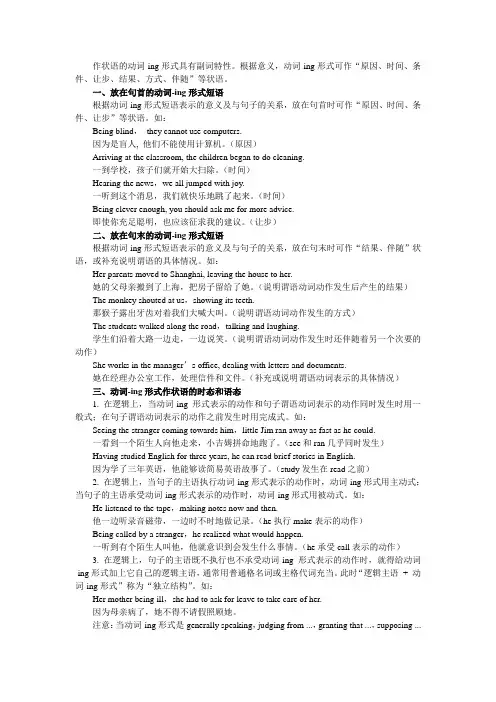
作状语的动词-ing形式具有副词特性。
根据意义,动词-ing形式可作“原因、时间、条件、让步、结果、方式、伴随”等状语。
一、放在句首的动词-ing形式短语根据动词-ing形式短语表示的意义及与句子的关系,放在句首时可作“原因、时间、条件、让步”等状语。
如:Being blind,they cannot use computers.因为是盲人, 他们不能使用计算机。
(原因)Arriving at the classroom, the children began to do cleaning.一到学校,孩子们就开始大扫除。
(时间)Hearing the news,we all jumped with joy.一听到这个消息,我们就快乐地跳了起来。
(时间)Being clever enough, you should ask me for more advice.即使你充足聪明,也应该征求我的建议。
(让步)二、放在句末的动词-ing形式短语根据动词-ing形式短语表示的意义及与句子的关系,放在句末时可作“结果、伴随”状语,或补充说明谓语的具体情况。
如:Her parents moved to Shanghai, leaving the house to her.她的父母亲搬到了上海,把房子留给了她。
(说明谓语动词动作发生后产生的结果)The monkey shouted at us,showing its teeth.那猴子露出牙齿对着我们大喊大叫。
(说明谓语动词动作发生的方式)The students walked along the road,talking and laughing.学生们沿着大路一边走,一边说笑。
(说明谓语动词动作发生时还伴随着另一个次要的动作)She works in the manager’s office, dealing with letters and documents.她在经理办公室工作,处理信件和文件。
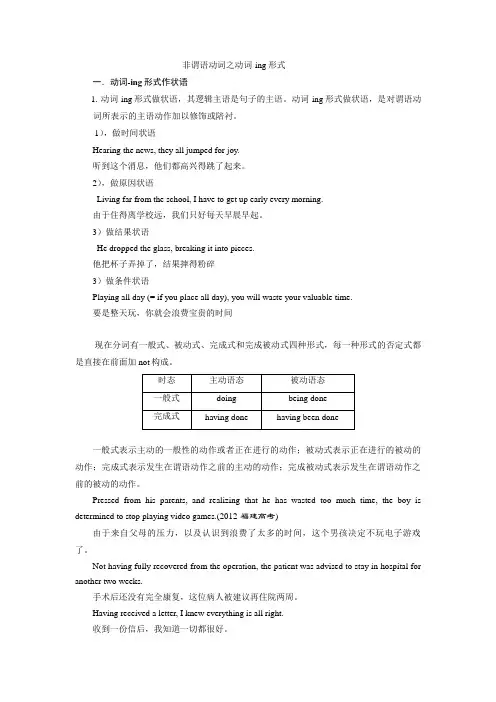
非谓语动词之动词-ing形式一.动词-ing形式作状语1. 动词-ing形式做状语,其逻辑主语是句子的主语。
动词-ing形式做状语,是对谓语动词所表示的主语动作加以修饰或陪衬。
1),做时间状语Hearing the news, they all jumped for joy.听到这个消息,他们都高兴得跳了起来。
2),做原因状语Living far from the school, I have to get up early every morning.由于住得离学校远,我们只好每天早晨早起。
3)做结果状语He dropped the glass, breaking it into pieces.他把杯子弄掉了,结果摔得粉碎3)做条件状语Playing all day (= if you place all day), you will waste your valuable time.要是整天玩,你就会浪费宝贵的时间现在分词有一般式、被动式、完成式和完成被动式四种形式,每一种形式的否定式都是直接在前面加not构成。
一般式表示主动的一般性的动作或者正在进行的动作;被动式表示正在进行的被动的动作;完成式表示发生在谓语动作之前的主动的动作;完成被动式表示发生在谓语动作之前的被动的动作。
Pressed from his parents, and realizing that he has wasted too much time, the boy is determined to stop playing video games.(2012·福建高考)由于来自父母的压力,以及认识到浪费了太多的时间,这个男孩决定不玩电子游戏了。
Not having fully recovered from the operation, the patient was advised to stay in hospital for another two weeks.手术后还没有完全康复,这位病人被建议再住院两周。
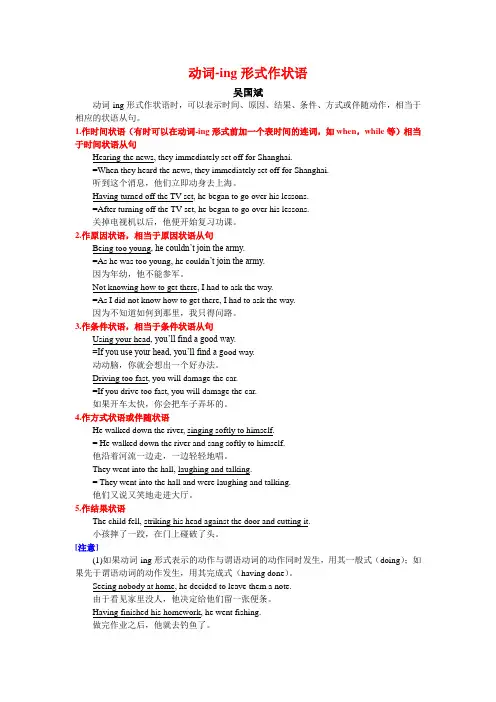
动词-ing形式作状语吴国斌动词-ing形式作状语时,可以表示时间、原因、结果、条件、方式或伴随动作,相当于相应的状语从句。
1.作时间状语(有时可以在动词-ing形式前加一个表时间的连词,如when,while等)相当于时间状语从句Hearing the news, they immediately set off for Shanghai.=When they heard the news, they immediately set off for Shanghai.听到这个消息,他们立即动身去上海。
Having turned off the TV set, he began to go over his lessons.=After turning off the TV set, he began to go over his lessons.关掉电视机以后,他便开始复习功课。
2.作原因状语,相当于原因状语从句Being too young, he couldn’t join the army.=As he was too young, he couldn’t join the army.因为年幼,他不能参军。
Not knowing how to get there, I had to ask the way.=As I did not know how to get there, I had to ask the way.因为不知道如何到那里,我只得问路。
3.作条件状语,相当于条件状语从句Using your head, you’ll find a good way.=If you use your head, you’ll find a g ood way.动动脑,你就会想出一个好办法。
Driving too fast, you will damage the car.=If you drive too fast, you will damage the car.如果开车太快,你会把车子弄坏的。
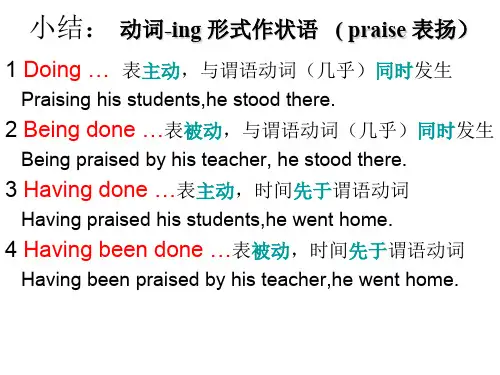
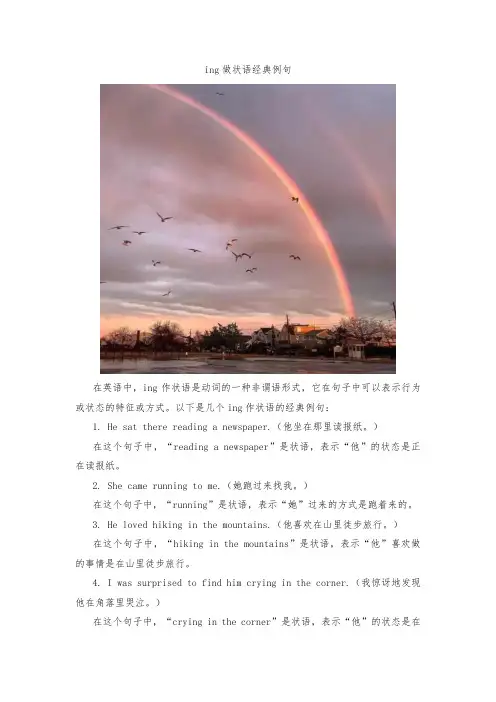
ing做状语经典例句在英语中,ing作状语是动词的一种非谓语形式,它在句子中可以表示行为或状态的特征或方式。
以下是几个ing作状语的经典例句:1. He sat there reading a newspaper.(他坐在那里读报纸。
)在这个句子中,“reading a newspaper”是状语,表示“他”的状态是正在读报纸。
2. She came running to me.(她跑过来找我。
)在这个句子中,“running”是状语,表示“她”过来的方式是跑着来的。
3. He loved hiking in the mountains.(他喜欢在山里徒步旅行。
)在这个句子中,“hiking in the mountains”是状语,表示“他”喜欢做的事情是在山里徒步旅行。
4. I was surprised to find him crying in the corner.(我惊讶地发现他在角落里哭泣。
)在这个句子中,“crying in the corner”是状语,表示“他”的状态是在角落里哭泣。
5. She swam across the river to reach the other side.(她游过河到达了另一边。
)在这个句子中,“across the river”是状语,表示“她”游泳的方式是横着游过河。
6. He jumped up and down excitedly.(他兴奋地跳上跳下。
)在这个句子中,“excitedly”是状语,表示“他”跳跃的方式是因为兴奋而跳跃。
7. She sang beautifully, much to our surprise.(她唱得很美,让我们大吃一惊。
)在这个句子中,“beautifully”是状语,表示“她”唱歌的方式是唱得很美。
8. He lay in bed, awake all night.(他躺在床上,整夜没睡。
)在这个句子中,“awake all night”是状语,表示“他”的状态是整夜保持清醒。
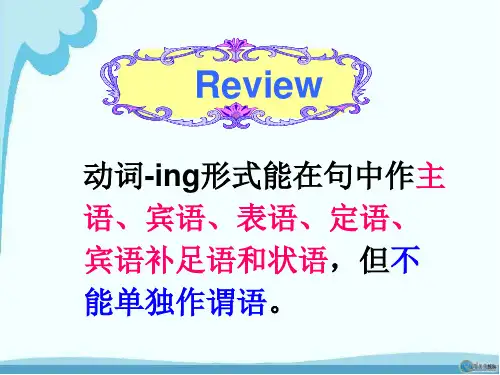
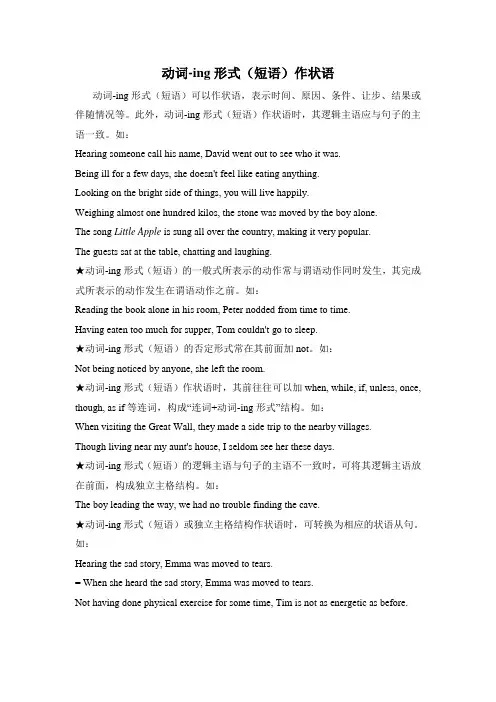
动词-ing形式(短语)作状语动词-ing形式(短语)可以作状语,表示时间、原因、条件、让步、结果或伴随情况等。
此外,动词-ing形式(短语)作状语时,其逻辑主语应与句子的主语一致。
如:Hearing someone call his name, David went out to see who it was.Being ill for a few days, she doesn't feel like eating anything.Looking on the bright side of things, you will live happily.Weighing almost one hundred kilos, the stone was moved by the boy alone.The song Little Apple is sung all over the country, making it very popular.The guests sat at the table, chatting and laughing.★动词-ing形式(短语)的一般式所表示的动作常与谓语动作同时发生,其完成式所表示的动作发生在谓语动作之前。
如:Reading the book alone in his room, Peter nodded from time to time.Having eaten too much for supper, Tom couldn't go to sleep.★动词-ing形式(短语)的否定形式常在其前面加not。
如:Not being noticed by anyone, she left the room.★动词-ing形式(短语)作状语时,其前往往可以加when, while, if, unless, once, though, as if等连词,构成“连词+动词-ing形式”结构。
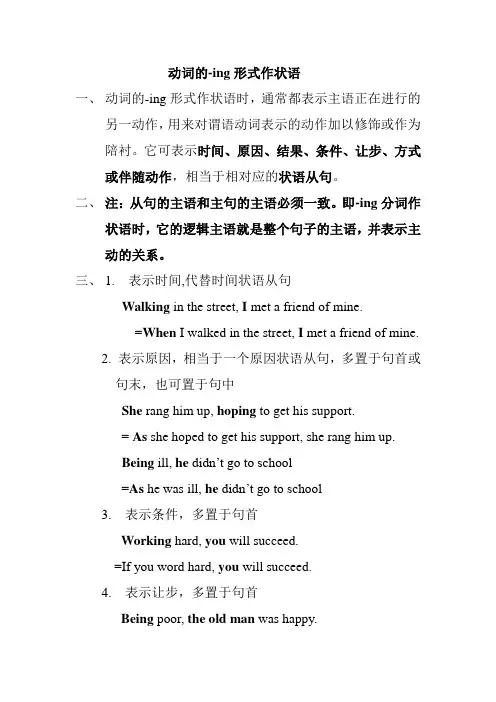
动词的-ing形式作状语一、动词的-ing形式作状语时,通常都表示主语正在进行的另一动作,用来对谓语动词表示的动作加以修饰或作为陪衬。
它可表示时间、原因、结果、条件、让步、方式或伴随动作,相当于相对应的状语从句。
二、注:从句的主语和主句的主语必须一致。
即-ing分词作状语时,它的逻辑主语就是整个句子的主语,并表示主动的关系。
三、1.表示时间,代替时间状语从句Walking in the street, I met a friend of mine.=When I walked in the street, I met a friend of mine.2. 表示原因,相当于一个原因状语从句,多置于句首或句末,也可置于句中She rang him up, hoping to get his support.= As she hoped to get his support, she rang him up.Being ill, he didn’t go to school=As he was ill, he didn’t go to school3.表示条件,多置于句首Working hard, you will succeed.=If you word hard, you will succeed.4.表示让步,多置于句首Being poor, the old man was happy.=Though he was poor, the old man was happy.5.表示结果,常置于句末The boy fell off his bike, breaking his right arm.= The boy fell off his bike, so he broke his right arm.6.表示方式或伴随,多置于句末,也可置于句首1) He sat at the table, reading a magazine.2) Laughing and talking, they went into the room.四、为强调与谓语动词的动作同时发生,在-ing形式短语前可用连词when, while等;为强调在谓语动词的动作之前或之后发生,在-ing形式短语前可用连词before或aftere.g. 1) Be careful when crossing the road.2) Don’t laugh while eating.3) Before going abroad, he lived here.4) After watching TV, he went to bed.五、在-ing形式短语前可用介词on,表示“一……就……”e.g. On arriving in Beijing, he went to see his uncle.(= As soon as he arrived in Beijing, he went to see his uncle.)。
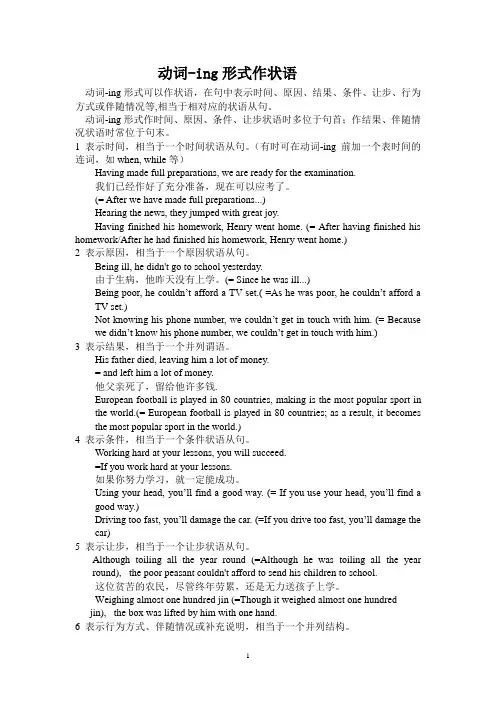
动词-ing形式作状语动词-ing形式可以作状语,在句中表示时间、原因、结果、条件、让步、行为方式或伴随情况等,相当于相对应的状语从句。
动词-ing形式作时间、原因、条件、让步状语时多位于句首;作结果、伴随情况状语时常位于句末。
1 表示时间,相当于一个时间状语从句。
(有时可在动词-ing前加一个表时间的连词,如when, while等)Having made full preparations, we are ready for the examination.我们已经作好了充分准备,现在可以应考了。
(= After we have made full preparations...)Hearing the news, they jumped with great joy.Having finished his homework, Henry went home. (= After having finished his homework/After he had finished his homework, Henry went home.)2 表示原因,相当于一个原因状语从句。
Being ill, he didn't go to school yesterday.由于生病,他昨天没有上学。
(= Since he was ill...)Being poor, he couldn’t afford a TV set.( =As he was poor, he couldn’t afford a TV set.)Not knowing his phone number, we couldn’t get in touch with him. (= Because we d idn’t know his phone number, we couldn’t get in touch with him.)3 表示结果,相当于一个并列谓语。
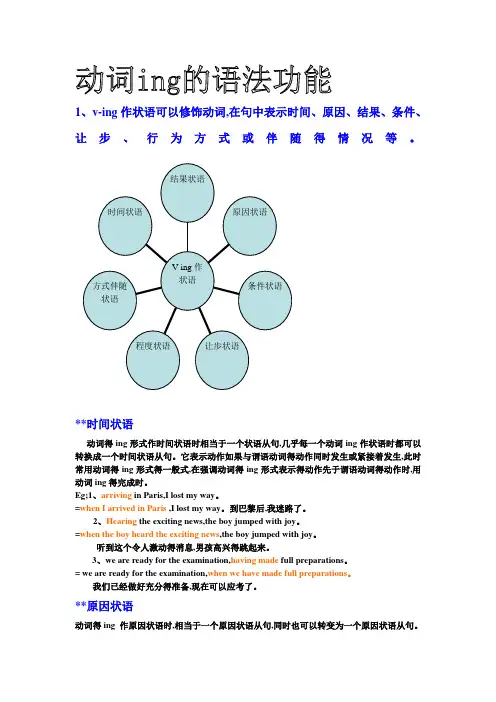
1、v-ing作状语可以修饰动词,在句中表示时间、原因、结果、条件、让步、行为方式或伴随得情况等。
**时间状语动词得ing形式作时间状语时相当于一个状语从句,几乎每一个动词ing作状语时都可以转换成一个时间状语从句。
它表示动作如果与谓语动词得动作同时发生或紧接着发生,此时常用动词得ing形式得一般式,在强调动词得ing形式表示得动作先于谓语动词得动作时,用动词ing得完成时。
Eg;1、arriving in Paris,I lost my way。
=when I arrived in Paris ,I lost my way。
到巴黎后,我迷路了。
2、Hearing the exciting news,the boy jumped with joy。
=when the boy heard the exciting news,the boy jumped with joy。
听到这个令人激动得消息,男孩高兴得跳起来。
3、we are ready for the examination,having made full preparations。
= we are ready for the examination,when we have made full preparations。
我们已经做好充分得准备,现在可以应考了。
**原因状语动词得ing 作原因状语时,相当于一个原因状语从句,同时也可以转变为一个原因状语从句。
它表示得原因得动词ing 形式短语一般置于句首。
Eg;1、having smoked too much ,he has suffered from lung cancer。
=as he has smoked too much ,he has suffered from lung cancer由于抽烟过多,她得了肺癌。
2、living far from my pany,I have to get up early。

非谓语动词用法解析动词ing作目的状语非谓语动词用法解析:动词-ing作目的状语动词-ing作目的状语是非谓语动词的一种常见用法。
在句子中,动词-ing形式可以作为目的状语,表示主语的动作或状态的目的或用途。
本文将对非谓语动词-ing作目的状语的用法进行详细解析。
一、形式动词-ing作目的状语的形式为动词的现在分词形式,即动词原形 + ing。
例如:1. I went shopping to buy some groceries.我去购物是为了买些杂货。
2. She stayed up late to finish her project.她熬夜是为了完成她的项目。
3. They studied hard to pass the exam.他们努力学习是为了通过考试。
二、用法1. 表示主语的目的或用途动词-ing作目的状语可以说明主语进行某个动作或处于某种状态的目的或用途。
例如:1. They traveled to experience different cultures.他们旅行是为了经历不同的文化。
2. The students worked hard to earn good grades.学生们努力学习是为了获得好成绩。
3. He went to the gym to build muscle.他去健身房是为了增肌肉。
2. 与动词不定式互换有些句子可以使用动词-ing作目的状语或动词不定式作目的状语,表示相同的意思。
这时候,动词-ing往往更常用于口语或非正式场合。
例如:1. He went to the store to buy milk. 或 He went to the store buying milk.他去商店是为了买牛奶。
2. She came to the party to meet new people. 或 She came to the party meeting new people.她来参加派对是为了结识新的人。
动词—ing形式作状语动词—ing形式可以作状语,在句中表示时间、原因、结果、条件、让步、行为方式或伴随情况等,相当于相对应的状语从句。
动词-ing形式作时间、原因、条件、让步状语时多位于句首;作结果、伴随情况状语时常位于句末。
1 表示时间,相当于一个时间状语从句。
(有时可在动词—ing前加一个表时间的连词,如when, while等)Having made full preparations, we are ready for the examination.我们已经作好了充分准备,现在可以应考了。
(= After we have made full preparations。
.。
)Hearing the news, they jumped with great joy.Having finished his homework, Henry went home. (= After having finished his homework/After he had finished his homework,Henry went home.)2 表示原因,相当于一个原因状语从句。
Being ill,he didn't go to school yesterday.由于生病,他昨天没有上学。
(= Since he was ill。
..)Being poor, he couldn’t afford a TV set.(=As he was poor, he couldn’t afford a TV set.)Not knowing his phone number,we couldn’t get in touch with him。
(= Because we didn't know his phone number, we couldn't get in touch with him。
ing分词作状语用法"ing"分词作状语是指将动词的现在分词形式作为句子中的状语,用来修饰句子的主语、谓语、宾语或整个句子。
"ing"分词作状语时可以表达时间、原因、方式、结果等不同的含义。
有以下几种常见的用法:1. 时间状语:表示主动的动作与谓语动词同时进行,或者谓语动作在其之后发生。
例如:- Walking in the park, I saw a beautiful flower. (当我在公园里散步时,我看到了一朵美丽的花。
)- After finishing my homework, I went to bed. (完成作业后,我去睡觉了。
)2. 原因状语:表示动词的原因或理由。
例如:- Being tired, she decided to take a nap. (因为累了,她决定小睡一会儿。
)- Knowing that she was late, he ran to catch the bus. (知道她迟到了,他跑去赶公车。
)3. 方式状语:表示动作的执行方式或方式特征。
例如:- She spoke to the audience, using simple and clear language. (她向观众们讲话时,使用简单明了的语言。
)- He drove home, carefully avoiding any traffic violations. (他小心地开车回家,避免任何交通违章。
)4. 结果状语:表示主句动作的结果。
例如:- The wind was blowing, making the trees sway. (风吹得树木摇摆不定。
)- The girl fell off her bike, hurting her knee. (女孩从自行车上摔下来,伤到了膝盖。
)需要注意的是,"ing"分词作状语时,一般位于句子的开头或中间,与句子的主语之间不加逗号分隔。
动词ing形式作状语你知道吗?有时候生活就像一杯茶,时而温暖,时而苦涩。
但无论它怎么样,你总得学会喝。
比如,走在街头,听着路边的小贩大声叫卖着,忽然就想起,原来“走”这个字也能带来这么多意思。
走路的时候,四周的一切仿佛都在自己眼前慢慢展开,走着走着,突然就想笑出来。
你看啊,走路其实就像是你自己对生活的一种态度,不管前方是泥泞还是阳光,脚步始终不停歇。
嗯,这不就是动词ing形式作状语的最好例子吗?你走着走着,心情也就慢慢放松了,甚至心里那点小烦恼都像风一样飘走了,剩下的就只剩下“走”的意义了。
真的,这种状态好像是个魔法,随时都能把你从日常的压力中抽离出来。
再说说跑步。
说到跑步,很多人脑袋里第一时间就会浮现出满身汗水的运动员,那个“跑步”的状态肯定很拼命。
可你仔细想想,跑步不仅仅是把身体往前推,更像是一种释放。
一开始,你可能会觉得气喘吁吁,心脏快要跳出胸口,腿部肌肉也在抗议。
但是慢慢地,你发现那种累并不是真的不行,而是让你有了一种新的自由。
尤其是那种一边跑,一边用力呼吸的感觉,简直就像是整个世界都变得安静,只剩下你和你的节奏。
你能听见自己的心跳,也能感受到空气在你耳边呼啸。
没错,就是这种“跑”着的感觉,让人瞬间觉得一切烦恼都没那么重要了。
你看,跑步不仅仅是身体在动,心情也在随之起舞。
那种感觉,简直是醍醐灌顶,让人恍若隔世。
然后呢,再说说做饭。
哎呀,做饭真的是一件充满魔力的事。
尤其是你站在厨房里,手忙脚乱地切菜、翻锅、煮汤,眼前的一切似乎都变得美好起来。
每一次锅铲的翻动、每一次食材的碰撞,都像是为生活添加了一些新的色彩。
你看,一切都在“做”的过程中发生变化。
是的,做饭不止是给肚子填饱,而是一种享受,一种投入。
当你用心地在锅里翻腾时,内心的那个不安静的声音竟然也被这些味道填满了。
你闻到蒜香四溢,看到锅中食物渐渐成型,突然间,你就发现自己也在变化——变得更加从容,也变得更懂得珍惜那些简单的幸福。
做饭,真的是个能治愈心灵的小秘密。
ing做状语"ing"作为状语时,通常可以表达动作的同时进行、原因、方式、条件等含义。
以下是一些常见用法和例句:1. 时间状语:表示动作的同时进行。
- She was singing while cooking dinner.(她一边做饭一边唱歌。
)- They were laughing and playing in the park.(他们在公园里笑着玩耍。
)2. 原因状语:表示动作的原因或引起的结果。
- He lost his keys, making him late for work.(他丢了钥匙,导致他上班迟到。
)- Being tired, she decided to take a nap.(因为累了,她决定小睡一会儿。
)3. 方式状语:表示动作的方式或方式特征。
- She won the race by running fast.(她通过跑得快赢得了比赛。
)- He solved the problem by studying hard.(他通过努力学习解决了问题。
)4. 条件状语:表示动作发生的条件。
- Having enough money, they decided to go on a trip.(有足够的钱,他们决定去旅行。
)- Without your help, we couldn"t have finished the project.(没有你的帮助,我们无法完成这个项目。
)需要注意的是,使用"ing"作为状语时,要确保逻辑上的连贯性和语法正确性。
同时,根据具体语境和句子结构的需要,可能还需要结合其他词或短语来表达更完整的意思。